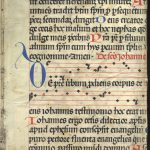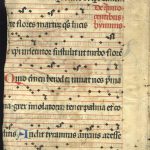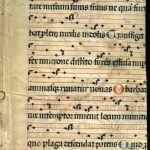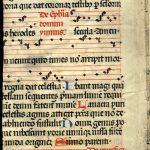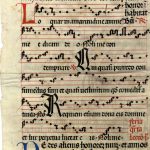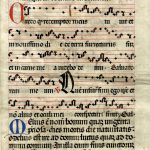Both fragments come from the corpus of the Psalterium Budense (Cathedral Library of Esztergom, Ms. I.3b), and they came into the possession of the Library of the HAS as part of the heritage of Nándor Knauz. Both fragments were identified by Janka Szendrei; first she determined their inherence with the Psalterium Budense kept in Esztergom as a short catalogue entry (1981), later she presented a detailed description of the fragment with allocating the provenance of the manuscript in a separate article (1986).
The hymnary fragment K 480.I preserved pieces of a bifolio’s two leaves: it contains parts of the hymns of saints tempore Nativitatis, and the hymn of Epiphany’s vespers. The quondam bifolio was the innermost element of a quire, hence the content is continuous on the inner pages of the fragment beside the crease. Along with the identical hands and notation, the fragment shows other characteristics of the Psalterium Budense’s hymnary: in the case of certain hymns (Stephano primo martyri, De Patre Verbum prodiens, Hostis Herodes impie) only the first strophe is notated, while the piece for the Holy Innocents (Salvete flores martyrum) has music written above the entire text. In the case of the latter hymn its irregular text justifies this practice. Some strophes contain lines with odd syllables, thus the notation greatly supports the clear application of the melody. The hymnary preserved in the mother codex is edited in the same manner. It is clear from the above, that the Psalterium Budense was made for practical use, though its impressive look could also imply a representative purpose.
The choice of certain melodies of the hymns stayed unchanged in the subsequent Esztergom use, see the psalter of Miklós Oláh (München, Bayerische Staatsbibliothek, Res/2 Liturg. 380, fol. 110v–112r, 125v; edited as: Psalterium Strigoniense Venetiis 1523 (Psalterium Nicolai Olahi), ed. Gábriel Szoliva, Musicalia Danubiana 25, Bavarica et Hungarica 2. Budapest: HAS, Research Centre for the Humanities, Institute for Musicology, 2015).
Folio II, which contains the Office of the Dead’s matins (lections and responsories), is complete. Its text precisely complements the text of the mother codex, which is broken on its former 129th (now 36th) folio’s verso, as Szendrei wrote in her detailed analysis. Similarly, the mother codex’s former 131st (now 38th) folio’s recto unfailingly continues the fragment’s verso.
Gábriel Szoliva


